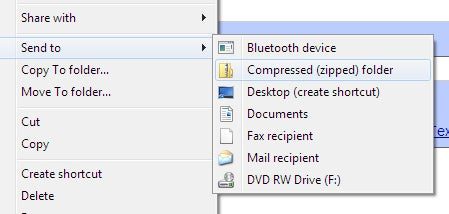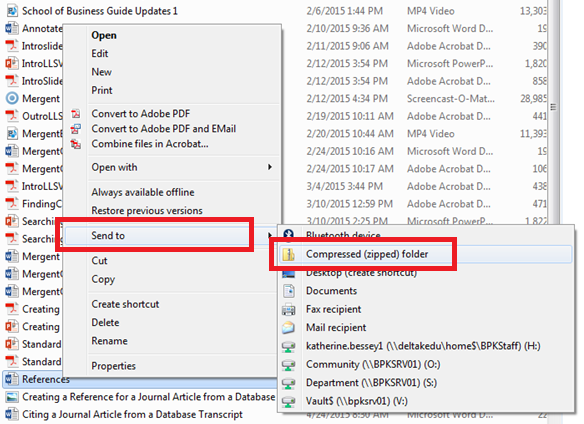Compress Files

Compressing files reduces their size and integrates data compression techniques for efficient storage. Compressing files is essential for reducing file sizes, saving storage space, and making data transfer more efficient.
By utilizing data compression techniques, files can be zipped or compressed into more compact and manageable formats. This process involves identifying repetitive data patterns and replacing them with unique identifiers that occupy less space. Several tools and software are available for file compression, offering various levels of compression to suit individual needs.
Compressing files can be particularly useful when sending large attachments via email, as it helps in minimizing upload and download times. Additionally, compressing files can also aid in organizing and archiving data effectively. Overall, understanding how to compress files is beneficial for optimizing storage capacity and enhancing data management processes.

Credit: www.wikihow.com
Benefits Of Compressing Files
Compressing files reduces size by applying data techniques, optimizing storage, and improving transfer speeds for efficiency. It allows easier file sharing, saves disk space, and speeds up data transfers, benefiting users with improved organization and faster accessibility.
Reduces File Size Significantly
Compressing files is a highly effective method to reduce the size of individual files or folders. By applying data compression techniques, redundant data patterns are scanned and replaced with unique identifiers that take up less space, resulting in a significant reduction in file size. This reduction is particularly useful when dealing with large files or when limitations on storage space are a concern.
Enhances Storage Efficiency
One of the key advantages of compressing files is the enhanced storage efficiency it offers. By reducing file sizes, compressing files enables users to store a larger quantity of files within a limited amount of storage space. This not only helps to optimize storage utilization but also allows for easier file management and organization.
Methods Of File Compression
File compression is the process of reducing the size of one or more files by applying data compression techniques. These techniques involve scanning for repetitive data patterns and replacing them with unique identifiers that take up less space.
Using Zip Utilities
One of the most common methods of file compression is using ZIP utilities. This involves zipping (compressing) a file or folder by selecting the option to create a compressed (zipped) folder. This results in a new zipped folder with the same name as the original, but with a significantly reduced file size. Additionally, most ZIP utilities offer different compression levels, allowing users to choose maximum compression for even greater reduction in file size. Removing unnecessary files from the ZIP file can further optimize the compression process, ensuring that only essential files are included.
Online File Compressors
Another accessible option for file compression is utilizing online file compressors. These tools provide a convenient way to reduce the file size of various file types, including PDFs, images, and videos. Online file compressors typically allow users to select the compression level needed for their specific files, ensuring that the desired balance between file size reduction and quality is achieved. Examples of online file compressors include WeCompress, a reliable and widely-used platform for compressing PDFs, PowerPoint, Word, JPEG, PNG, and TIFF files.
Tips For File Compression
File compression is crucial for efficient storage and transfer of data. It can significantly reduce the file size, making it easier to manage large volumes of data. Here are some essential tips for effective file compression:
Choosing Maximum Compression Level
When compressing files, selecting the maximum compression level can significantly reduce the file size. Most compression tools offer various compression levels, and opting for the maximum level can yield more significant reductions in file size compared to using default settings.
Removing Unnecessary Files
Before compressing files, it’s essential to review the contents and remove any unnecessary files. By eliminating redundant or obsolete files, you can streamline the compression process and ensure that only essential data is included in the compressed file.

Credit: www.parallels.com
Implications Of File Compression
File compression has various implications, especially when it comes to compressing files. By reducing file size through data compression techniques, you can save storage space, improve file transfer speeds, and enhance efficiency in handling large files. Compressing files is a simple and effective way to optimize your digital workflow.
File compression plays a crucial role in various aspects of file management and sharing. Understanding the implications of file compression can help individuals and businesses optimize their file storage, transfer, and collaboration processes.
Preserving File Quality
One concern with file compression is the potential loss in quality. When files are compressed, data is removed or rearranged to reduce the file size. This can result in a degradation of the file’s original quality. However, modern compression algorithms and techniques strive to minimize such quality loss.
By using advanced compression methods, file formats like JPEG and MP3 can achieve significant reductions in size while maintaining an acceptable level of visual or auditory fidelity. These algorithms identify and remove redundant data that does not contribute significantly to the overall perception of quality.
| Benefits of preserving file quality |
|---|
| – Smaller file sizes without significant loss of visual or auditory quality |
| – Enhanced storage capacity and reduced bandwidth consumption |
| – Quick sharing and transferring of high-quality files |
Ease Of File Sharing
Another implication of file compression is the ease of sharing files across different platforms and networks. Compressed files require less storage space and can be transferred faster than their uncompressed counterparts. This makes them ideal for email attachments, uploading to cloud storage services, or sending over the internet.
Moreover, compressed files can be easily decompressed and accessed by recipients without specialized software or tools. This ensures hassle-free collaboration and sharing of files, eliminating the need for all parties involved to have the same software or file formats.
- Key advantages of ease of file sharing with compression:
- – Reduced transfer times due to smaller file sizes
- – Compatibility across different platforms and systems
- – Streamlined collaboration and communication processes
Tools For File Compression
File compression tools are essential for optimizing storage space and enhancing file transfer efficiency. Two popular tools for file compression are Adobe Acrobat Compress PDF and YouCompress.
Adobe Acrobat Compress Pdf
Adobe Acrobat Compress PDF is a reliable tool for reducing the size of PDF files without compromising quality. It allows users to select the compression level based on their requirements, ensuring optimized file sizes for easy sharing and storage.
Youcompress
YouCompress is an online file compressor that supports a variety of file types including images, PDFs, and videos. This user-friendly tool makes it simple to reduce file sizes while maintaining the integrity of the content, making it a valuable resource for quick and efficient file compression.

Credit: rasmussen.libanswers.com
Frequently Asked Questions Of Compress Files
How Do I Reduce The Mb Size Of A File?
To reduce the MB size of a file, you can use low resolution images, compress images within documents, and save as PDF. Additionally, you can zip the file or folder and choose maximum compression. Also, consider removing unnecessary files. Online file compressors such as WeCompress and Adobe Acrobat can help too.
How Do I Compress Large Files?
To compress large files, right-click on the file or folder, select “Send to,” then choose “Compressed (zipped) folder” to create a new zipped folder with the same name. Use maximum compression levels and remove unnecessary files to reduce ZIP file size.
Utilize online tools, such as WeCompress or Adobe Acrobat, for convenient file compression.
What Does It Mean To Compress A File?
Compressing a file means reducing its size by using data compression techniques. This involves finding repetitive data patterns and replacing them with smaller identifiers. To compress a file, you can use software or tools that allow you to zip or compress the file, reducing its overall size.
Compressing files helps save storage space and makes it easier to share or transfer files.
How Do I Reduce The Mb Of A Zip File?
To reduce the MB size of a ZIP file, use maximum compression levels and remove unnecessary files before zipping.
Conclusion
Compressing files is a simple yet effective way to reduce their size and optimize storage space. By using low-resolution versions of images, compressing images within documents, and saving files in a compressed folder, you can easily reduce the MB size of your files.
Additionally, removing unnecessary files and choosing maximum compression can further decrease file size. Compressing files not only saves storage space but also helps in faster file transfer and optimization. So, start compressing your files today and enjoy the benefits of efficient file management.
